When you get a brand new carbon steel wok, you have to season it first before putting it in good use. Follow these simple instructions on how to season a carbon steel wok.
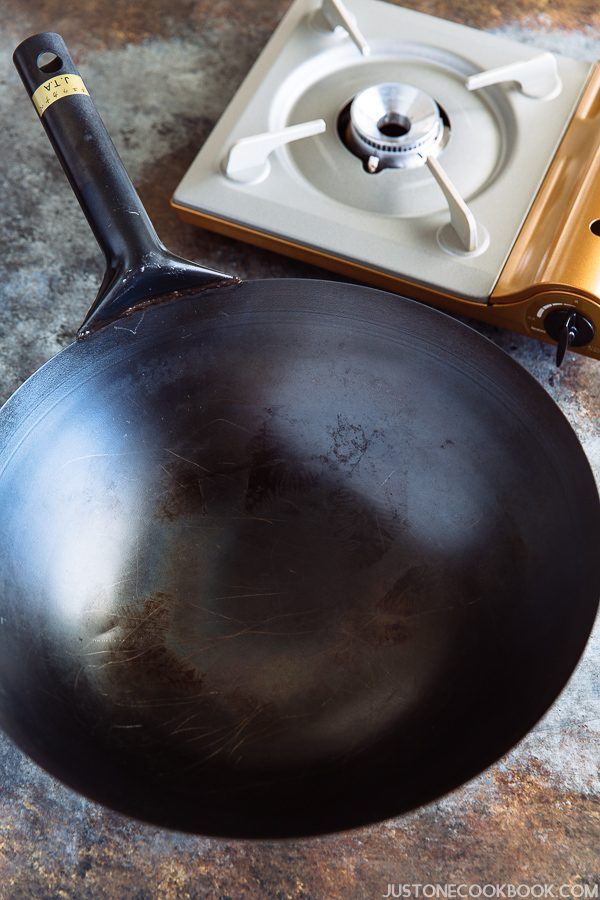
Carbon Steel – My Choice of Wok
I’ve been interested in purchasing a good wok that I can use for a very long time. After searching high and low for the perfect wok in the market, I finally picked up this 14-inch carbon steel wok several months ago. The wok is similar to the one that my mom has been using faithfully in her kitchen for many years. When my wok arrived, I couldn’t hold my excitement for the piece of cookware I have been waiting for and immediately put it in good use.
In the past, I had used Calphalon stainless steel stir fry wok from Costco. The price was great, but after cooking with it many times, I realized the heat distribution of the wok is not optimal.
Then I purchased the All-Clad stainless steel stir fry pan, which has 5-ply bonded construction with stainless steel, aluminum, and a thick copper core for even heating. It worked fairly well and I immediately noticed the difference in heat distribution which was the problem with my first wok. The drawback of the pan though is food tends to stick unless you put enough oil, and it doesn’t develop the desirable char taste to foods. All in all, the All-Clad pan is still a good and convenient cookware. I actually enjoy using it. If carbon steel is not your choice, I highly recommend this.
Here’s a quick glance at the differences between a carbon steel wok and the other types of woks
Woks are made of different materials with various price range, sizes and shapes. Selecting the right wok for your cooking can be as confusing as buying a car if you are not familiar with it or cook with one before. Luckily, a good, reliable wok happens to be the least expensive cookware you need to invest in the kitchen.
Carbon Steel Wok VS. Non Stick, Stainless Steel, and Cast Iron Woks
Weight – Carbon steel is a lighter material compared to stainless steel or cast iron. For stir frying, carbon steel wok is ideal since it is easier to maneuver for picking up and flipping the ingredients in rapid motion.
Heat distribution – Carbon steel wok heats up quickly and transfers the heat evenly. The foods get a nice sear in seconds the moment they touch the heated wok. Non stick woks, on the other hand, cannot handle high heat, which is least ideal for any foods that require cooking in high temperature. For cast iron, it takes longer time to heat up and cool down, which can be problematic for stir fry or dishes that require flash cooking.
Durability – If you take good care and use it frequently, carbon steel wok will form its own nonstick coating and last you a lifetime. Rust may occur if you do not use the wok regularly, but that doesn’t mean you have to replace it with a new one. To remove the rust, you just need to rust it off and re-season the wok again.
Versatility – Amongst the different woks, carbon steel wok is one of the most all-around cook pans you can imagine. In addition to stir-frying, it is also great for steaming, deep frying, shallow frying, boiling, blanching, smoking and so on.
And above all, the beauty of a carbon steel wok is its ability of imparting a nice char flavor to the foods you cook in. In Japanese kitchen, wok is called a chūkanabe 中華鍋 as in Chinese pot. Just like the Chinese, we believe that a good working wok is best for stir fry dishes such as Yasai Itame (stir fry vegetables), Tan-Men, Shrimp Fried Rice etc. The hot wok, fast motion and working synergy that give foods a concentrated flavor and aroma is incontestable.
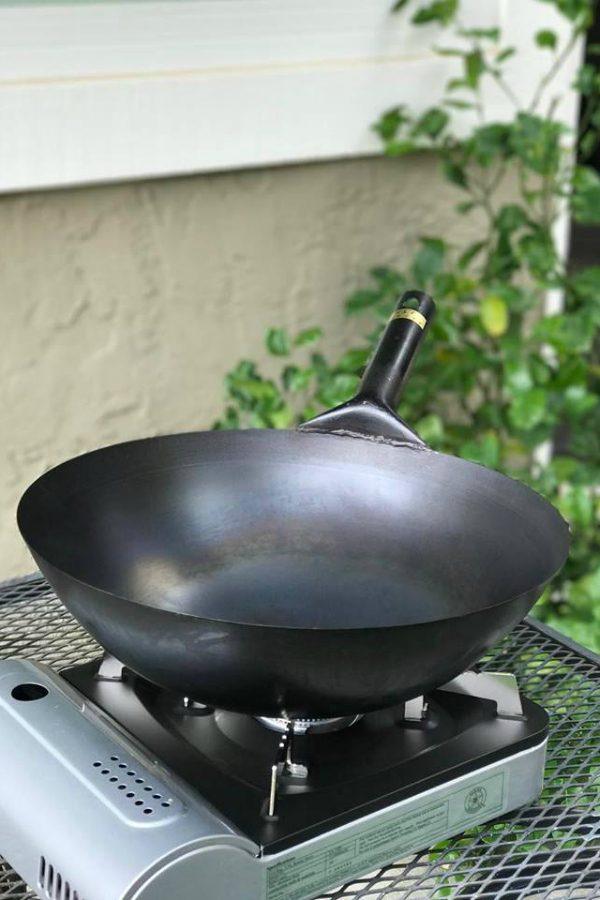
Carbon steel woks arrived from the factory are covered in an anti-rust coating. There are many different ways to “burning” the wok to get rid of the coating. I recommend seasoning the wok OUTSIDE of the house to be safe. It will create a lot of smoke, and you don’t want that inside your house. Once the seasoning is done, you just have to make sure to use the wok as frequent as you can. Like a good pal in the kitchen, the more you use it, the better it gets.
How to Season a Wok
What You Need:
- 1 unseasoned 14-inch carbon-steel wok
- dish soap
- stainless steel scrubber
- sponge (I use Japanese tawashi brush)
- 1 cup high smoking oil (peanut oil, canola oil, grape seed oil and sunflower oil, but NOT olive oil)
- 1 onion, roughly sliced
- metal spatula
- stainless steel strainer
- large pot
- paper towel
Instructions:
Before you start: Set up your working station
I recommend doing this process outside the house using a portable gas burner (that you use for hot pot and camping) because the chemicals on the wok is not safe to breathe in. If you have no choice but to do it inside the house, make sure your kitchen is thoroughly ventilated by opening the windows and turning on the exhaust fan.
Prepare all the ingredients and equipment ahead of time so you do not have to be away from the wok once you start the cooking oil.
Step 1: Wash the inside and outside of the wok
Using a ball of steel wool, thoroughly scrub and wash the inside and outside of the wok in hot, soapy water. This will remove some of the factory machine oil applied by the manufacturer to keep it from rusting. Rinse with hot water and dry wok with a clean dry towel.
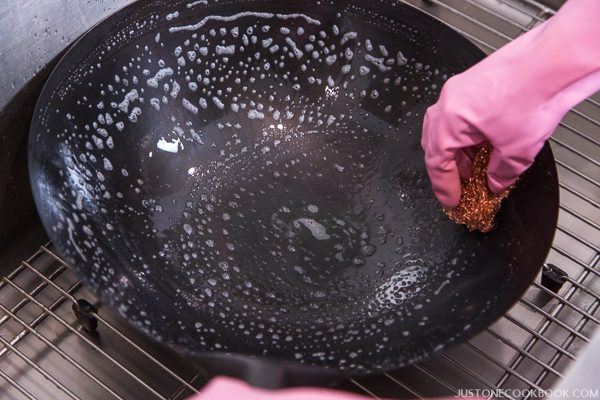
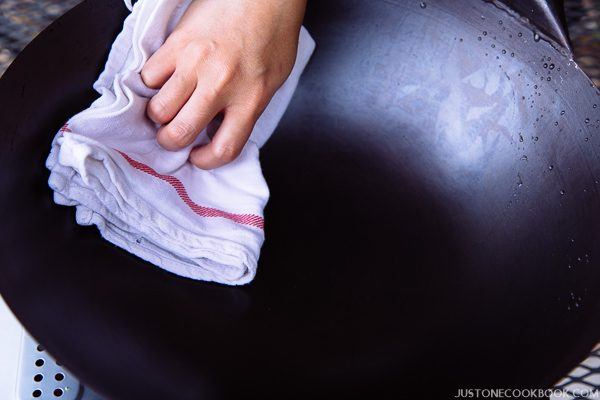
Step 2: Burn the wok to remove factory oil
Place the wok on stovetop over high heat and start burning the wok. It will discolor from the center of the wok (Do you see blue-grayish color now?). Move the wok, slowly turning and tilting it up to the rim and back until the entire wok changes color.
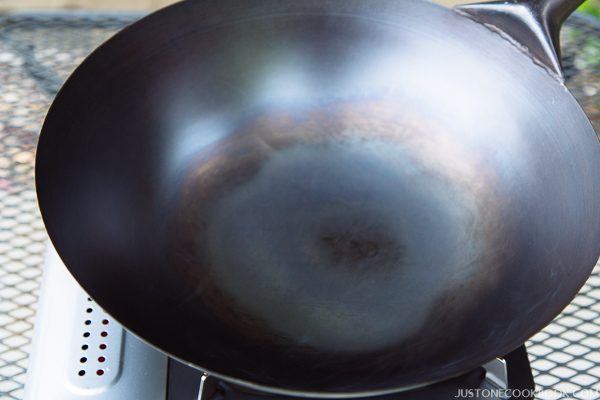
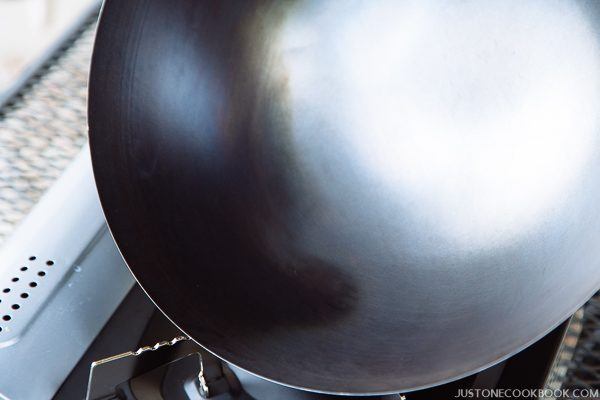
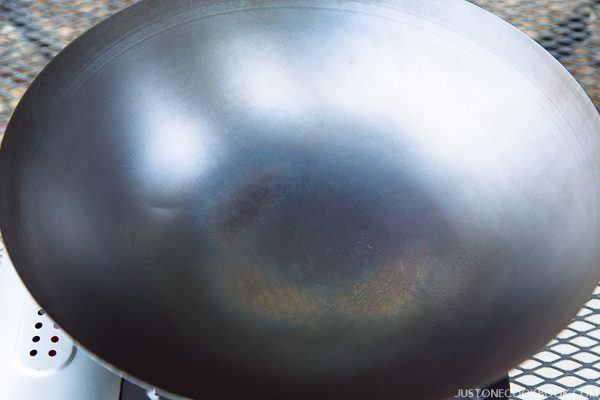
Step 3: Rinse and dry wok
Using a sponge or the soft side of a scrubber (I use Japanese tawashi brush made of natural palm fibers), wash the inside and outside of the wok in hot water (no dish soap) and dry the wok with a dry towel. Place the wok on stovetop over medium heat to completely dry and turn off the heat immediately when water droplets are evaporated.
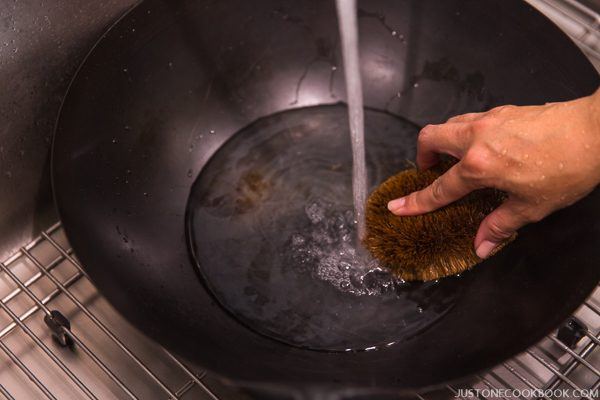
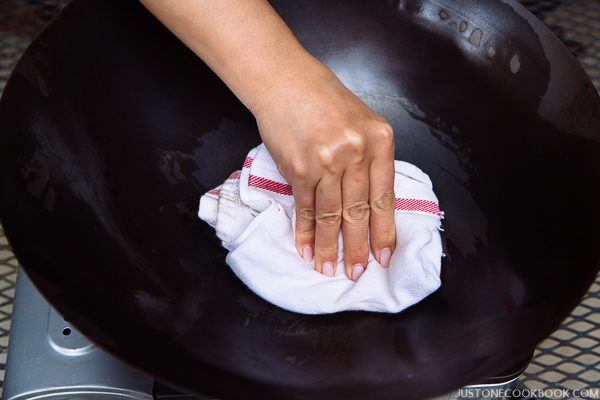
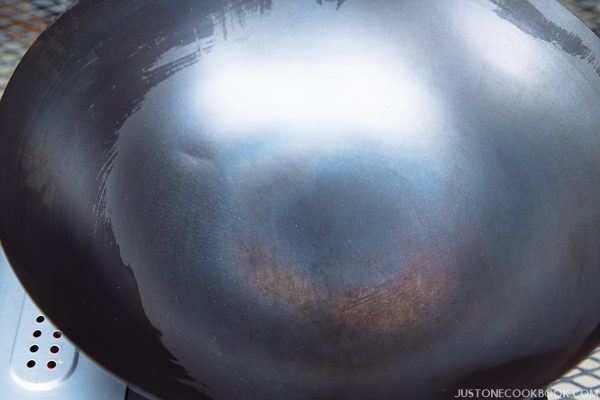
Step 4: Fry vegetable(s) in oil
Add high smoking oil (peanut oil, canola oil, grape seed oil, and sunflower oil, but NOT olive oil) in the wok and heat up the oil over high heat. Add the onion slices, and use the stir fry motion to move both onions and oil around to coat the entire inside of the wok. Cook for about 15 minutes. Pungent vegetables or aromatics such as garlic cloves, green onions, and ginger will reduce the amount of smoke produced.
When you use the wok over time, the wok will eventually turn into a nice deep black that will act as a natural non-stick coating.
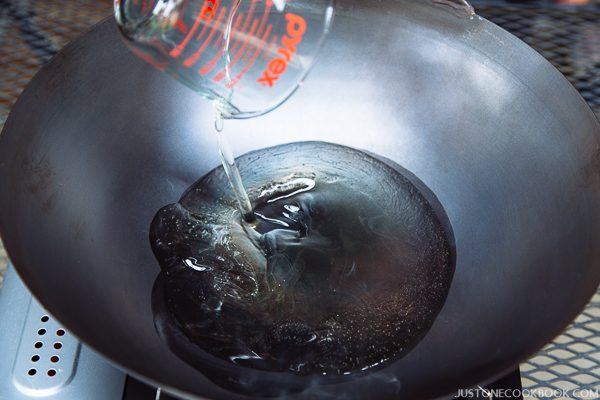
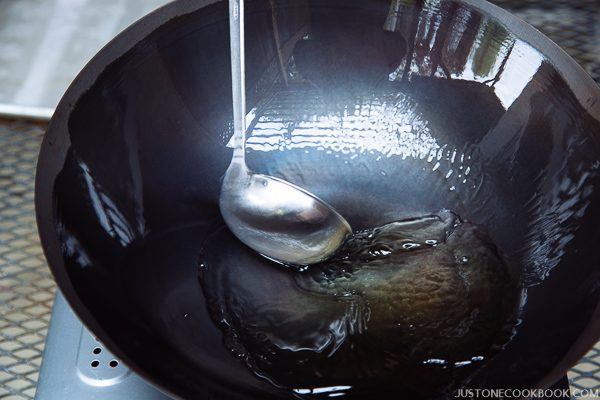
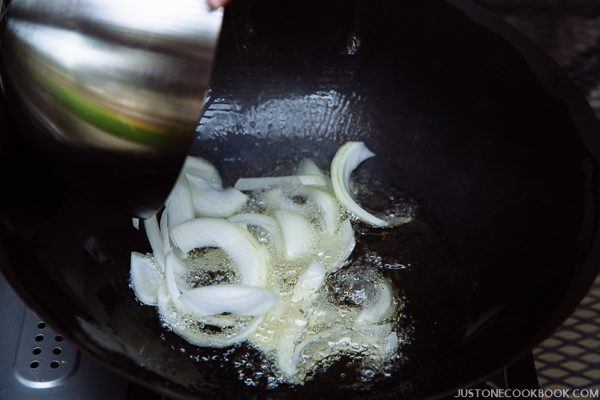
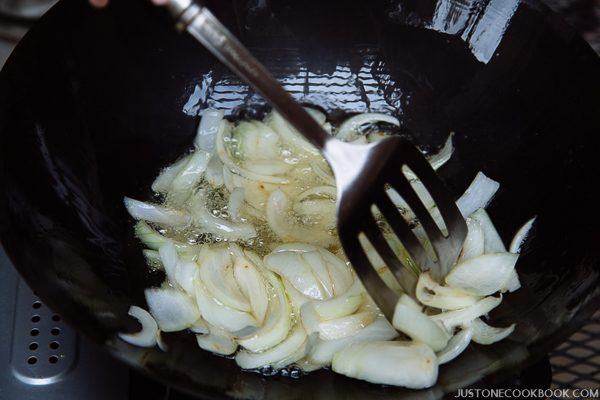
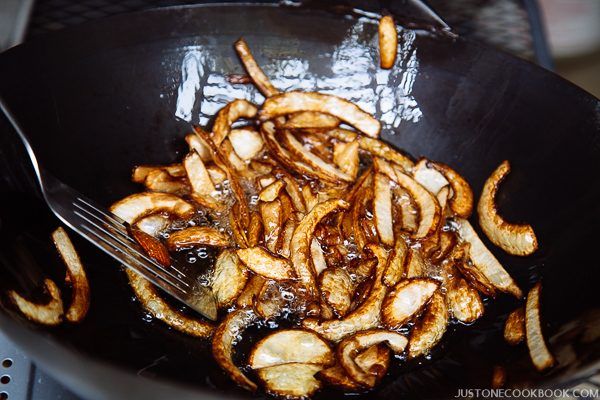
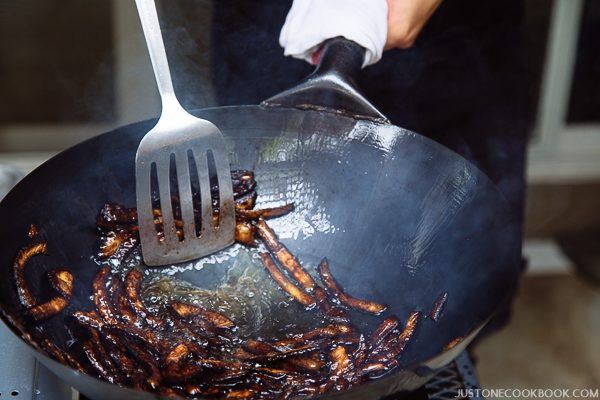
Step 5: Drain the oil (and vegetables) in strainer and wipe off the wok
Once the wok is seasoned well with the oil, drain it over the sieve placed over a large pot. Wipe off the oil with paper towel. The wok is now ready to use.
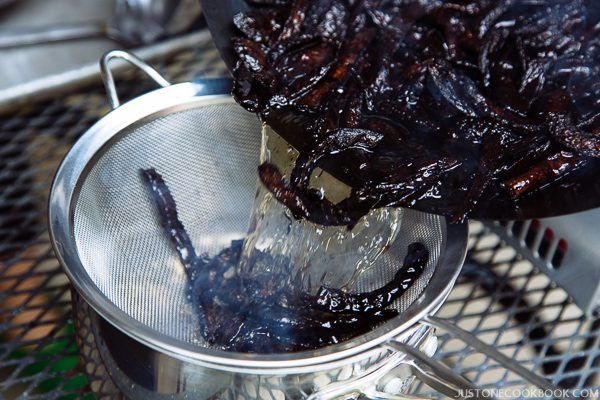
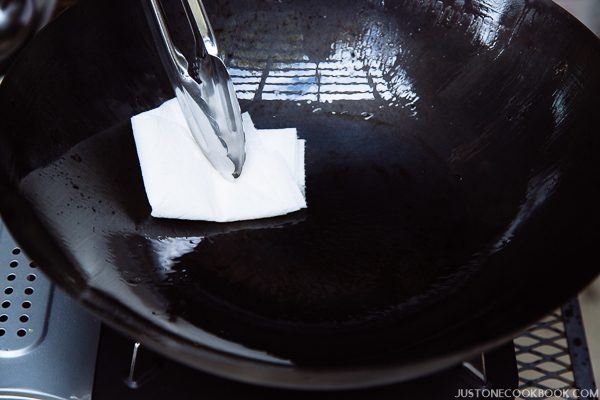
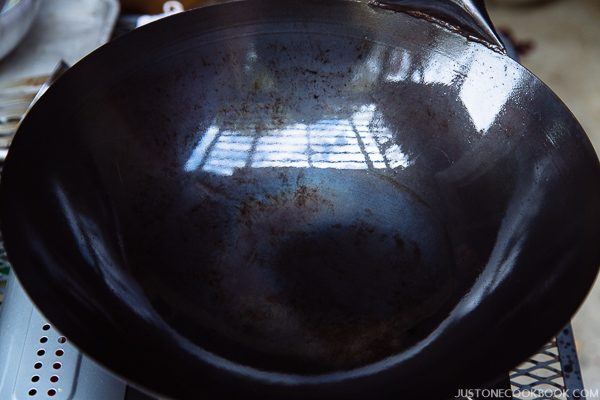
Step 6: Rinse and dry wok
Using a sponge or the soft side of a scrubber (I use Japanese tawashi brush made of natural palm fibers), wash the inside and outside of the wok in hot water (no dish soap) and dry the wok with a dry towel. Place the wok on the stovetop over medium heat to completely dry and turn off the heat immediately when water droplets are evaporated. Let cool completely before storing it.

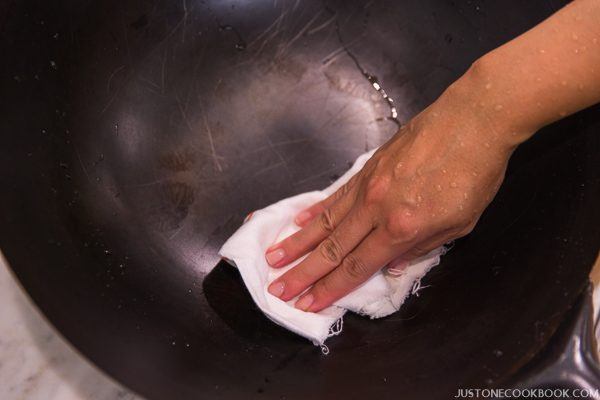
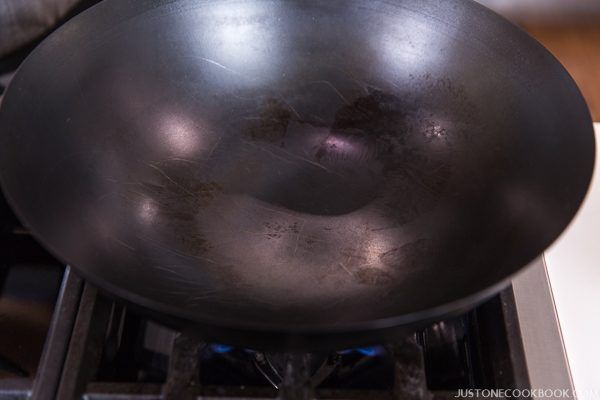
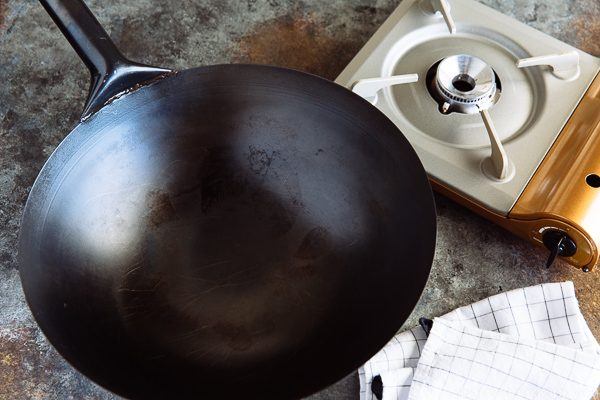
Step 7: Washing and maintaining the wok
The wok is easy to maintain and will last a long time in your kitchen with these simple instructions.
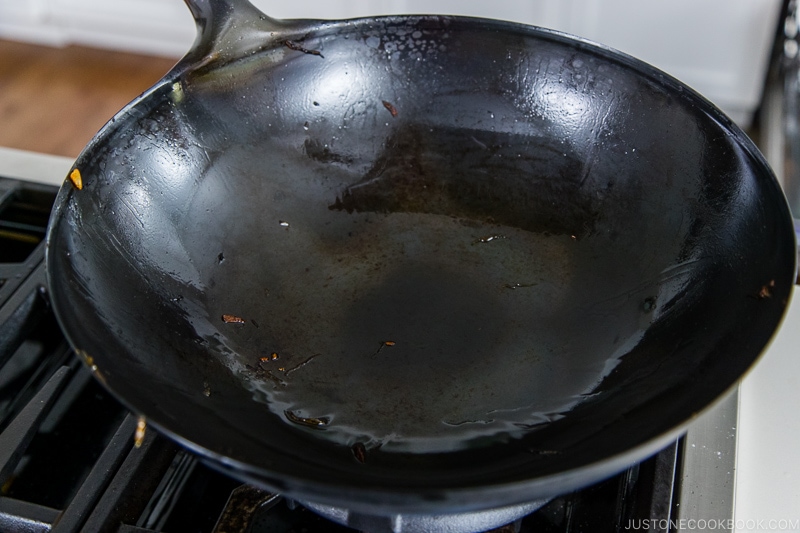
Avoid using dish soap to wash the wok. Immediately after cooking rinse with really hot water and remove stubborn food scraps with a brush.
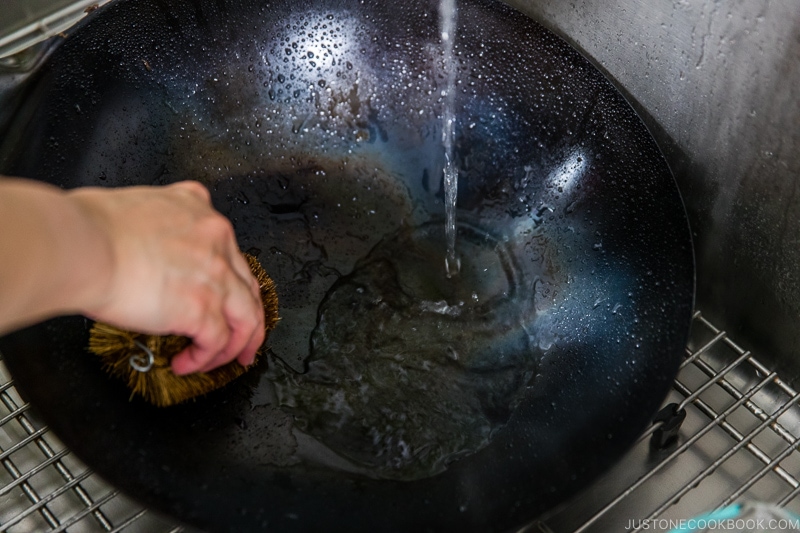
Wipe the wok dry and heat up on the stove. Season lightly with oil and turn off the heat when the oil starts smoking.
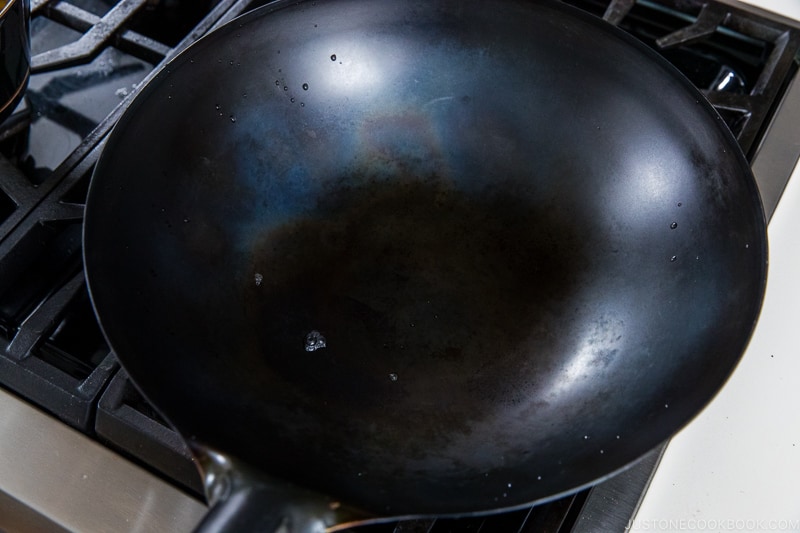
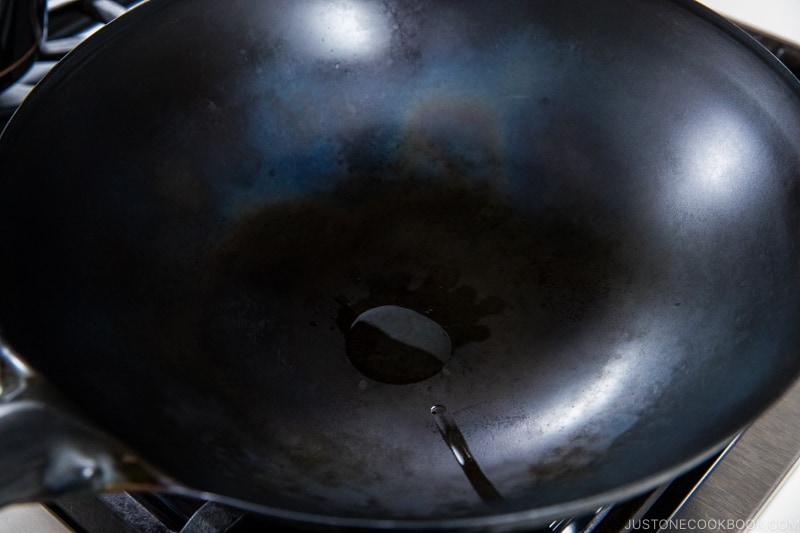
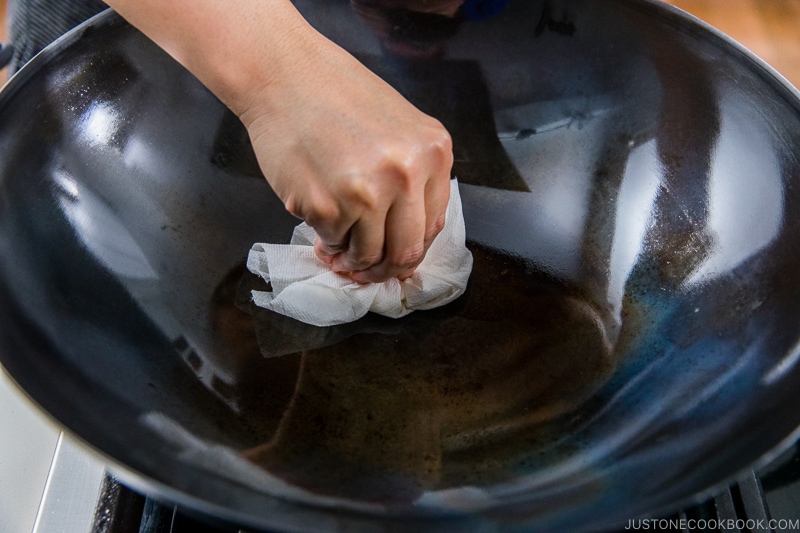
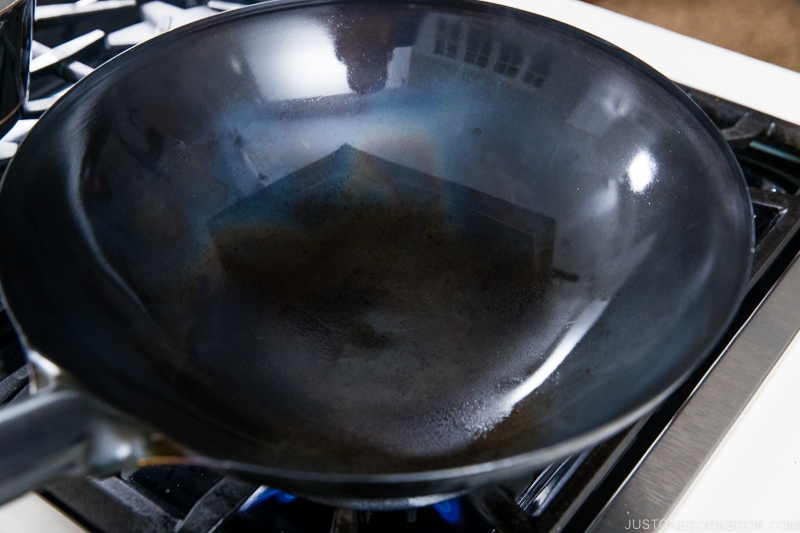
With these step-by-step pictures, I hope you will be inspired to get your first wok and start cooking up delicious stir fry dishes. If you already own a wok and it is sitting in the dark corner of your kitchen, it’s time to break it out, re-season and give the wok a new lease of life.
Recipes you might want to try with your newly seasoned wok:
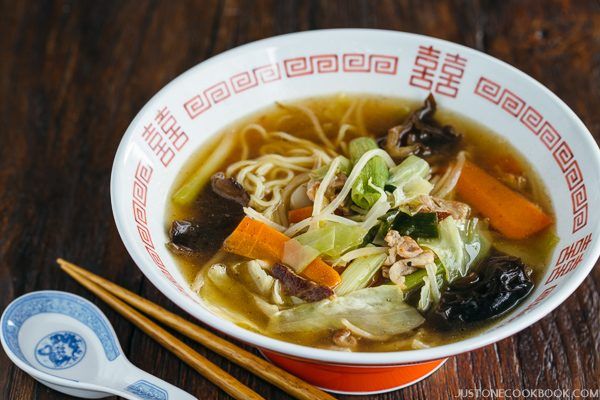

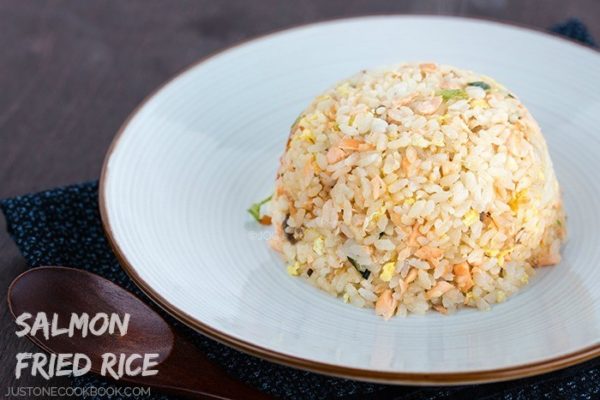
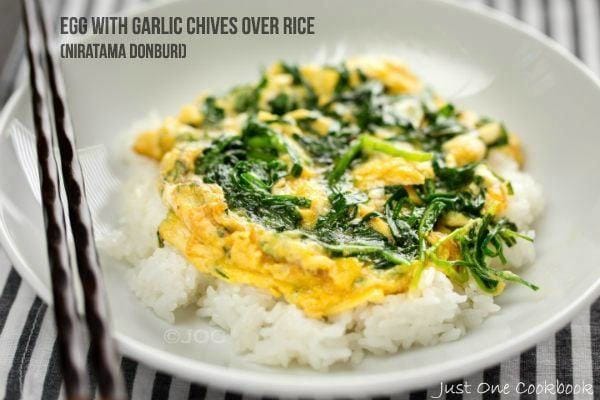
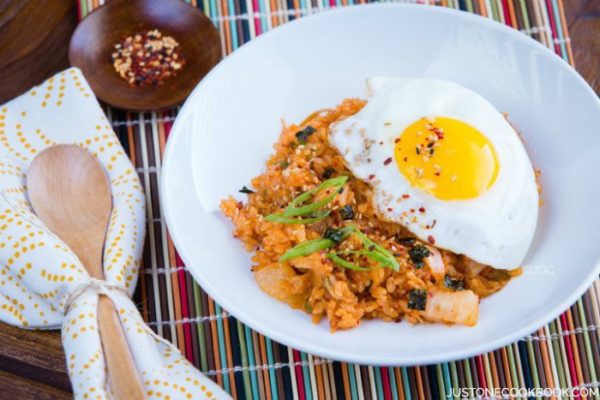
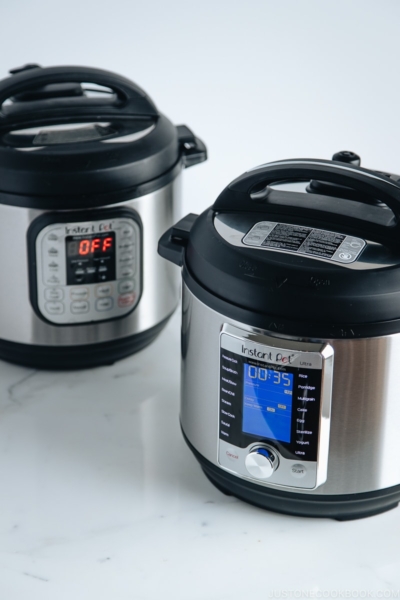
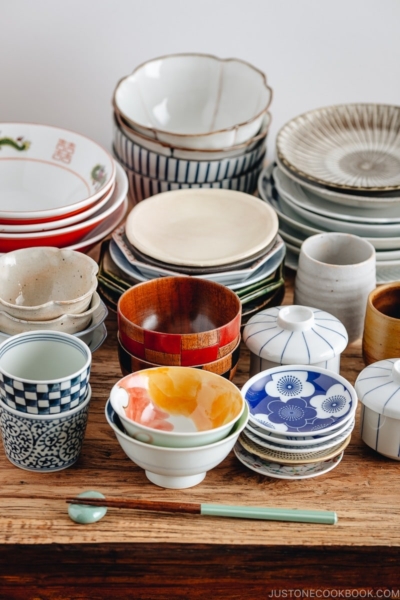
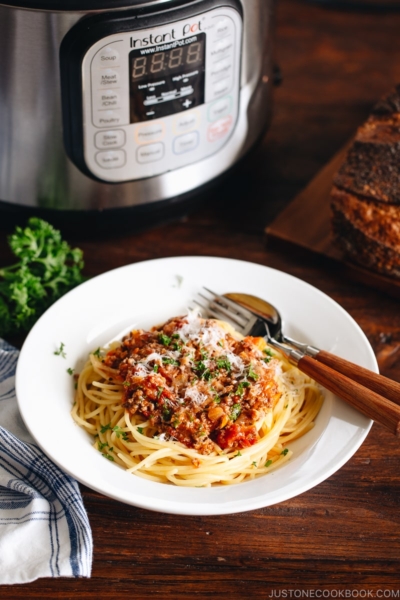
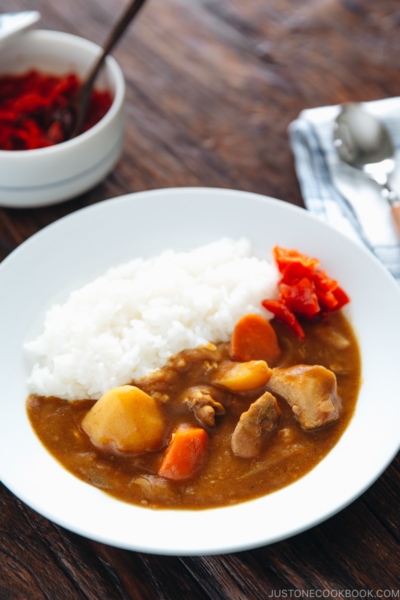





Hi, when I click on the link, it says it is metal…not carbon steel? Ps, I LOVE your newsletter, recipes and JOC goods. You have been a huge inspiration!
Hello, sunshine! Thank you for reading Nami’s post and for your kind words on her newsletter and JOC products. We’re delighted you’re enjoying them! 🥰
We looked into a link, and the wok is made of carbon steel. Additional information can be found in the “about this item” section. Hope this helps!
I bought a wok and it had rust; is that safe to use or should I just dispose of it?
Hi Gemma! Rust may occur if you do not use the wok regularly.
To remove the rust, simply rust it off, wash it, then re-season the wok.
If you recently purchased it and noticed rust, we recommend returning it to the store for an exchange.🙂
We hope this helps!
HI!
Unfortunately, I do not have a gas range. It is electric (coils). Are there any woks that work well with electric or will I have to just cook using a portable burner?
Hi Phil! Yeah you have two ways.
1) As you said, get a portable gas burner like this one I like (https://amzn.to/3aPQVF2) and you have more options for woks.
2) Some flat bottomed woks work with an electric stove: https://www.kitchenbar.net/wok-for-electric-stove/
It’s a lot easier to cook over gas stove though. And portable burner is great for hot pot at the table in wintertime! 🙂
Do you have a link where we can purchase the wok you are using?
Hi Trish! Thank you very much for reading Nami’s post!
The link for 14″ Japanese Style Steel Wok is on this post under “Carbon Steel – My Choice of Wok”. Please click the red letter, 14″ Japanese Style Steel Wok!
We hope you enjoy this Wok soon.😊
Hi! I bought a 27cm wok (北京鍋)from Japan, very similar to the one in your picture. At first I thought it was carbon steel since it is very light and it heats up quickly. However reading the manufacturer’s website (Kanda 神田) I found out that it’s actually cast iron (鉄黒皮 表面加工/クリアラッカー塗装). I’ve seen these woks in many places in Japan and they seem to be more popular than carbon steel. What do you think about these woks? Do they need similar care as carbon steel woks?
Hi Sabastian,
Yes, they need the same care. After using, don’t wash with soap and rinse with hot water. Dry wok and season with a bit of oil and heat until smoke.
It should last a very long time if you take good care of it and not let it rust.
konnichi wa
may i ask, this is for preparing wok for 1st use.
When daily using, how do you take care of the wok?
what do you do in between dishes, how to clean the wok?
after cooking, how do you wash and keep?
Do you use soap? do you re-oil again before storing?
I am re-oiling every night after washing, the smoke and smell fills the whole house and i really struggle with it. Do you have any suggestions?
Hi Bop76! Yes, this was originally written for preparing wok for the first use. I updated the post with the maintenance. We’ll add the image after taking pictures of the maintenance tomorrow. 🙂
https://www.justonecookbook.com/how-to-season-a-wok/
Being stuck with electric stoves in apartments, I often prepared and used my woks over a charcoal starter chimney, turned upside down in a outdoor grill. Six to ten charcoal briquettes were enough to get the high heat and burned long enough to cook several dishes as long as you had everything ready to go, plus time to clean, heat dry and oil your wok after cooking. As money allowed, I later bought a portable high BTU gas burner for the wok.
Hi Bear! Thank you for sharing your experience with us! I see you’re very serious about cooking (and eating good food)! I see the passion to make good food! 🙂
Hi where did you buy the carbon wok?
Hi Joliza! I bought mine from Amazon: https://amzn.to/2gKtDaO
Very good ???? Bravo Zulu very informative!
Thank you ???? very much
Thank you for reading, Vic! 🙂
This is so helpful! I’ve been somewhat satisfied with the wok I have but I’m definitely looking to get a new one. Perfect timing, thank you so much Nami!
Thanks for reading this post, Damie! Glad it is helpful. 🙂
Thanks for the article. How do you keep your seasoned wok clean after each use? Do you use soap with water and sponge?
Hi Shu! Use hot water (and soap if it is very hard to come off) and sponge to wash. It’s important to heat the wok to dry and season it with oil after washing. 🙂
Hi, I followed the link but it says wok for commercial use only… at this point I am not sure I should buy it or not.
Any recs/thoughts?
Hi Stef,
Nami uses this wok in her home kitchen. However, You will need a wok ring to attach to your gas stove for the round bottom.
If carbon steel is not your choice, she highly recommends this All-Clad 6414 SS Copper Core 5-Ply Bonded Dishwasher Safe Open Stir Fry Pan / Cookware, 14-Inch, Silver
https://www.amazon.com/gp/product/B000B6NXSO/ref=as_li_qf_sp_asin_il_tl?ie=UTF8&tag=jusonecoo-20&camp=1789&creative=9325&linkCode=as2&creativeASIN=B000B6NXSO&linkId=9273f4746803d7af42722f9771653459
We hope this helps!
Thank you for this very useful information. I have tried several different woks over the years and have been disappointed. I will definitely get a carbon steal wok.
Hi Pamela! Thanks for reading this post. Hope you will enjoy using a carbon steel wok in the future! 🙂
Nami: I am looking for a 10 inch or larger frying pan of Japanese cast iron. Do you have any preferred pans or brands. Japanese cast is lighter andin the end they just make a better product. Thanks, Jim Hunter
Hi Jim! So you’re looking for 10-inch Japanese cast iron frying pan…
https://www.amazon.co.jp/%E9%81%A0%E8%97%A4%E5%95%86%E4%BA%8B-AHL20026-%E9%89%84%E9%BB%92%E7%9A%AE%E5%8E%9A%E6%9D%BF%E3%83%95%E3%83%A9%E3%82%A4%E3%83%91%E3%83%B3-26cm/dp/B002LV4WTG/ref=sr_1_3?ie=UTF8&qid=1504593953&sr=8-3&keywords=%E9%89%84%E9%8D%8B%E3%83%95%E3%83%A9%E3%82%A4%E3%83%91%E3%83%B3
This one looks good, but sold on Amazon Japan… The US site has mostly Lodge brand…
Sorry I can’t find the Japanese one here…